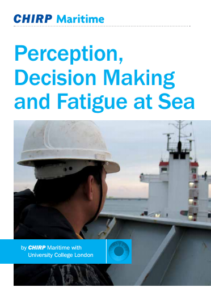CHIRP released a book as well, called “Perception, Decision Making and Fatigue at Sea”, addressing how we see, and how the resulting perception is affected by the conditions seafarers face and how this affects their decision making.
The book, which was created in cooperation with the Arts & Sciences and Neuroscience Departments at University College London, provides important recommendations for seafarers and maritime operators, regarding the correlation between vision and perception.
Namely, it presents the way that eyes work with the brain. It specifically gives attention to the so-called “what and where”. The “what and where” is very important as it provides information about detail and colour. In order for the “where” system to work better, dim light is necessary, using peripheral vision and it adapts more easily to moving objects. However, “what and where” require different brain activity. This means that they can’t both peak simultaneously.
Moreover, the report says that there are five limitations that can affect someone’s vision, which are the following:
- Lighting
- Attention
- Size and distance
- What and where
- Adaptation

Furthermore, the book highlights the importance of human element during ship design and operating procedures as well. It notes that, the matter of vision must be further addressed by the shipping industry, as it can be proven a crucial factor for the safe operation of a ship and the safety of seafarers in general.
“Knowing about and understanding these issues and knowing how to avoid them is the route to first class and ever-improving seamanship. These guidelines highlight key issues in the areas of Perception and Decision Making, with makes recommendations on how we can combat them together, helping to make our ships more efficient and keeping our seas safe,” the report said.
You can learn more information about the book released by CHIRP, in the PDF herebelow































































